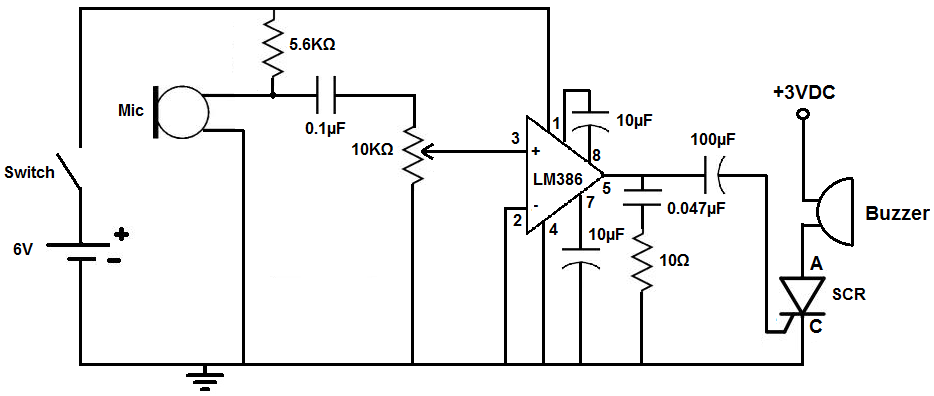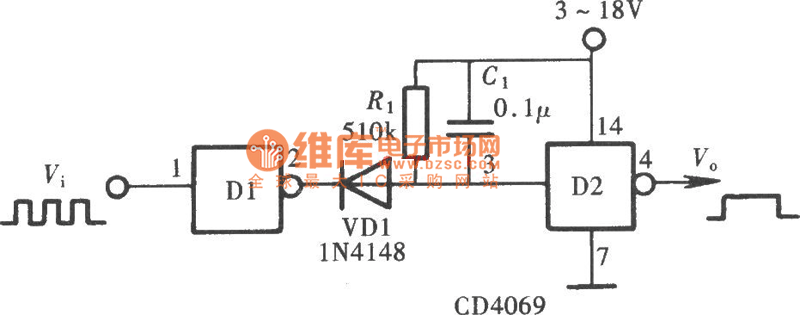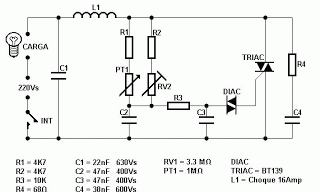
Sound Alarm Circuit

This circuit is designed to activate an alarm when it detects sound above a specified threshold. The alarm serves as a notification for any sound in areas that are typically quiet, such as quiet zones. Under normal quiet conditions, with minimal sound, the alarm remains inactive. However, when sounds are detected, such as footsteps or conversations, the alarm is triggered, allowing for the detection of unauthorized individuals in spaces where sound should not occur. The circuit comprises a microphone connected to an audio amplifier to enhance the signals. The amplifier used is the LM386 IC, which amplifies the microphone's output signals to a level that can be interpreted by an Arduino. The connections on the board include VCC (power supply), GND (ground), and AUD (output of the microphone). This setup simplifies the construction of the sound alarm circuit as it eliminates the need to assemble the electret microphone and amplifier separately. The LM386 pinout is crucial for understanding the connections made from the microphone. Terminals 1 and 8 control the amplifier's gain, with a 10µF capacitor placed between them for maximum voltage gain. Terminals 2 and 3 receive the sound input, where the electret microphone connects. Terminal 2 is the negative input, while terminal 3 is the positive input. Terminal 7, the Bypass terminal, is typically grounded or left open, but a capacitor is added for stability. R1 is a resistor that powers the microphone, while C1 blocks DC voltage at the input, allowing only AC signals to pass. C2 sets the voltage gain of the LM386, resulting in an output voltage 200 times greater than the input. C3 enhances the amplifier's stability, preventing oscillations that could distort sound signals. C5 acts as a current reservoir for output surges. The electret microphone captures sound and converts it into electrical signals, which are amplified by the LM386 IC and output through pin 5 to the Arduino for processing. The output signal connects to an analog terminal on the Arduino, allowing for sound level monitoring. If the sound level exceeds a certain threshold, an LED connected to digital pin D13 lights up, indicating the alarm condition.
The circuit operates by utilizing an electret microphone that converts acoustic signals into electrical signals. These signals are then fed into the LM386 audio amplifier, which is configured to boost the signal strength significantly. The gain of the amplifier is adjustable through the use of external components, specifically a capacitor connected between terminals 1 and 8, allowing for flexibility in the circuit’s responsiveness to sound levels.
The output from the LM386 is taken from pin 5 and sent to the Arduino, which processes this signal to determine if it exceeds the pre-defined threshold. The Arduino is programmed to monitor the analog input from the amplifier and trigger a digital output if the sound level surpasses a certain limit. This digital output is connected to an LED, which serves as a visual indicator of the alarm state.
In addition to the basic operation, the circuit design includes several capacitors that serve specific functions. For instance, C1 is critical for ensuring that only the AC component of the audio signal is passed to the amplifier, effectively filtering out any DC offset that could interfere with the detection of sound. Capacitors C2 and C3 enhance the amplifier's performance by stabilizing the gain and preventing unwanted oscillations, which could lead to false alarms or distorted sound output.
The arrangement of components and the careful selection of values for resistors and capacitors are essential for optimizing the sensitivity and reliability of the sound detection circuit. The design can be further refined by adjusting the gain settings or incorporating additional filtering stages if necessary, depending on the specific application requirements. Overall, this sound alarm circuit provides an effective solution for monitoring audio activity in designated quiet areas, ensuring timely alerts for any unauthorized sound events.This is a circuit that will go off if the circuit detects any sound above a certain threshold. Once the circuit detects sound, the alarm goes off alerting us to this sound. This circuit has extreme use when an area ordinarily should be very quiet and should have no sound like a quiet zone. Under quiet conditions, with little to no sound, the alarm will not go off. When a sound is detected such as someone walking through the room or talking in a room, the alarm will go off. Thus, we can detect intruders in a room that shouldn`t be there if they create sound while operating in a room where there shouldn`t be any.
So in order to build our circuit, we will use a microphone and connect it to an audio amplifier to get amplified signals. The amplifier IC that we use is the popular LM386 IC. This IC will amplify the output signals that the microphone produces so that the arduino will be able to detect large enough signals to interpret them.
All we need to do then is connect the 3 terminals on the board, which are VCC, GND, and AUD. Vcc is the power which we supply to the breakout board, so that the microphone and amplifier have sufficient power to operate. GND is the negative or return path of the power. And AUD is the output of the microphone board, which are the amplified sound signals. Using this board greatly simplifies the process of building our sound alarm circuit, since we don`t have to put the electret microphone and amplifier together.
However, if you do want to do so, do so. Again, click the above link to the circuit schematic. Before we show the complete schematic diagram of the arduino sound alarm circuit, we will first show the pinout of the LM386. This way, the connections that we make from the microphone to it will make more sense. Terminals 1 and 8 represent the gain control of the amplifier. These are the terminals where you can adjust the gain by placing a resistor and capacitor or just capacitor between these terminals.
In this circuit, we will place a 10G‚ µF capacitor between these terminals for the highest voltage gain. You can adjust this as necessary to adjust the gain, as needed. Terminals 2 and 3 are the sound input signal terminals. These are the terminals where you place the sound which you want to amplify. In our case for this circuit, the elecret microphone will be connected to these terminals. Terminal 2 is the -input and Terminal 3 is the +input. In our circuit, the positive microphone terminal will be placed on terminal 3 and terminal 2 will be connected to the negative microphone terminal, tied to ground.
Terminal 7 is the Bypass terminal. This pin is usually left open or is wired to ground. However, for better stability, a capacitor is added in our circuit because this can prevent oscillations in the amp chip. R1 is a resistor that connects the microphone to positive voltage so that the microphone is able to power on.
Microphones cannot work without the necessary power needed. C1 is a capacitor that blocks DC voltage on the input signal and allows AC to pass through. When we speak into a microphone, our voice or music is the AC signal. This is the only part of the signal that we want to pass through to output. The DC signal is only used to give power to the microphone; we do not want it to appear in output. This is why we use this capacitor. It blocks the DC but allows the AC to go into output. C2 is a capacitor that sets the voltage gain of the LM386 amplifier. Therefore, the voltage out is 200 times the voltage in. This provides us with the maximum gain that the LM386 can provide. C3 is a capacitor that improves the stability of the LM386 amplifier to prevent issues such as oscillations. Oscillation can distort sound signals, making them unclear or unintelligible. C5 is a capacitor that acts as a current bank for output. This capacitor drains when sudden surges of current occur and refills with electrons when the demand for current is low.
The circuit starts with the electret microphone. The microphone picks up sound signals and transforms them into electrical signals. These electrical signals are then amplified by the LM386 IC. These signals are then output through pin 5 of the amplifier IC, which are then fed to the arduino board to be processed. The output signal, again, comes from pin 5 of the LM386 IC. The positive terminal (+) goes into an analog terminal of the Arduino; we will connect it, in our case, to A0 of the analog terminal.
The negative terminal (-) connects to GND on the arduino. This allows us to process the output signal of the microphone. If we don`t speak into the microphone, it will pick up a faint signal and give us a very low reading. If we make loud noises such as shout, clap into the microphone, etc. , we will get a loud reading. We will program the software for the arduino to light up the LED attached to digital pin, D13, when a certain threshold of sound is reached.
The LED will light up and stay on unless power to the circuit is shut off. This way, our circuit functions as a sound alarm circuit. 🔗 External reference
The circuit operates by utilizing an electret microphone that converts acoustic signals into electrical signals. These signals are then fed into the LM386 audio amplifier, which is configured to boost the signal strength significantly. The gain of the amplifier is adjustable through the use of external components, specifically a capacitor connected between terminals 1 and 8, allowing for flexibility in the circuit’s responsiveness to sound levels.
The output from the LM386 is taken from pin 5 and sent to the Arduino, which processes this signal to determine if it exceeds the pre-defined threshold. The Arduino is programmed to monitor the analog input from the amplifier and trigger a digital output if the sound level surpasses a certain limit. This digital output is connected to an LED, which serves as a visual indicator of the alarm state.
In addition to the basic operation, the circuit design includes several capacitors that serve specific functions. For instance, C1 is critical for ensuring that only the AC component of the audio signal is passed to the amplifier, effectively filtering out any DC offset that could interfere with the detection of sound. Capacitors C2 and C3 enhance the amplifier's performance by stabilizing the gain and preventing unwanted oscillations, which could lead to false alarms or distorted sound output.
The arrangement of components and the careful selection of values for resistors and capacitors are essential for optimizing the sensitivity and reliability of the sound detection circuit. The design can be further refined by adjusting the gain settings or incorporating additional filtering stages if necessary, depending on the specific application requirements. Overall, this sound alarm circuit provides an effective solution for monitoring audio activity in designated quiet areas, ensuring timely alerts for any unauthorized sound events.This is a circuit that will go off if the circuit detects any sound above a certain threshold. Once the circuit detects sound, the alarm goes off alerting us to this sound. This circuit has extreme use when an area ordinarily should be very quiet and should have no sound like a quiet zone. Under quiet conditions, with little to no sound, the alarm will not go off. When a sound is detected such as someone walking through the room or talking in a room, the alarm will go off. Thus, we can detect intruders in a room that shouldn`t be there if they create sound while operating in a room where there shouldn`t be any.
So in order to build our circuit, we will use a microphone and connect it to an audio amplifier to get amplified signals. The amplifier IC that we use is the popular LM386 IC. This IC will amplify the output signals that the microphone produces so that the arduino will be able to detect large enough signals to interpret them.
All we need to do then is connect the 3 terminals on the board, which are VCC, GND, and AUD. Vcc is the power which we supply to the breakout board, so that the microphone and amplifier have sufficient power to operate. GND is the negative or return path of the power. And AUD is the output of the microphone board, which are the amplified sound signals. Using this board greatly simplifies the process of building our sound alarm circuit, since we don`t have to put the electret microphone and amplifier together.
However, if you do want to do so, do so. Again, click the above link to the circuit schematic. Before we show the complete schematic diagram of the arduino sound alarm circuit, we will first show the pinout of the LM386. This way, the connections that we make from the microphone to it will make more sense. Terminals 1 and 8 represent the gain control of the amplifier. These are the terminals where you can adjust the gain by placing a resistor and capacitor or just capacitor between these terminals.
In this circuit, we will place a 10G‚ µF capacitor between these terminals for the highest voltage gain. You can adjust this as necessary to adjust the gain, as needed. Terminals 2 and 3 are the sound input signal terminals. These are the terminals where you place the sound which you want to amplify. In our case for this circuit, the elecret microphone will be connected to these terminals. Terminal 2 is the -input and Terminal 3 is the +input. In our circuit, the positive microphone terminal will be placed on terminal 3 and terminal 2 will be connected to the negative microphone terminal, tied to ground.
Terminal 7 is the Bypass terminal. This pin is usually left open or is wired to ground. However, for better stability, a capacitor is added in our circuit because this can prevent oscillations in the amp chip. R1 is a resistor that connects the microphone to positive voltage so that the microphone is able to power on.
Microphones cannot work without the necessary power needed. C1 is a capacitor that blocks DC voltage on the input signal and allows AC to pass through. When we speak into a microphone, our voice or music is the AC signal. This is the only part of the signal that we want to pass through to output. The DC signal is only used to give power to the microphone; we do not want it to appear in output. This is why we use this capacitor. It blocks the DC but allows the AC to go into output. C2 is a capacitor that sets the voltage gain of the LM386 amplifier. Therefore, the voltage out is 200 times the voltage in. This provides us with the maximum gain that the LM386 can provide. C3 is a capacitor that improves the stability of the LM386 amplifier to prevent issues such as oscillations. Oscillation can distort sound signals, making them unclear or unintelligible. C5 is a capacitor that acts as a current bank for output. This capacitor drains when sudden surges of current occur and refills with electrons when the demand for current is low.
The circuit starts with the electret microphone. The microphone picks up sound signals and transforms them into electrical signals. These electrical signals are then amplified by the LM386 IC. These signals are then output through pin 5 of the amplifier IC, which are then fed to the arduino board to be processed. The output signal, again, comes from pin 5 of the LM386 IC. The positive terminal (+) goes into an analog terminal of the Arduino; we will connect it, in our case, to A0 of the analog terminal.
The negative terminal (-) connects to GND on the arduino. This allows us to process the output signal of the microphone. If we don`t speak into the microphone, it will pick up a faint signal and give us a very low reading. If we make loud noises such as shout, clap into the microphone, etc. , we will get a loud reading. We will program the software for the arduino to light up the LED attached to digital pin, D13, when a certain threshold of sound is reached.
The LED will light up and stay on unless power to the circuit is shut off. This way, our circuit functions as a sound alarm circuit. 🔗 External reference





